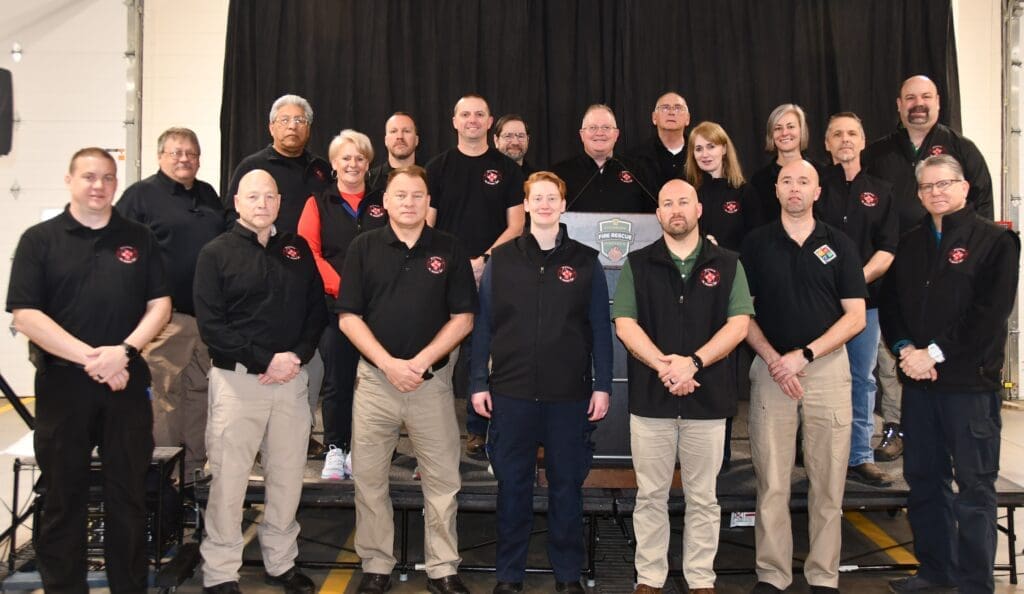
FITCHBURG, Wis. – Wisconsin’s emergency responders are often faced with complex and difficult decisions as they work to protect lives and property. While many overcome those challenges without outside help, sometimes the demands of an incident may exceed their capabilities. In those situations, they may make a request for an incident management team (IMT) to provide support.
An IMT is a team of experienced and well-trained staff who can assist local emergency responders with critical management tasks during an incident. This may include managing volunteers, establishing a logistics operation to distribute supplies, or overseeing the process of removing debris for the scene of a disaster. While there are multiple regional IMT groups in the state, and the Wisconsin Department of Natural Resources has three Regional Type 3 Teams primarily focused on wildfires and severe weather incidents, Wisconsin Emergency Management (WEM) last year began the process of forming a new state-sponsored Type 3 All-Hazards IMT.
“One of the major lessons learned coming out of the state’s COVID response was that we needed a more robust network of personnel to manage these complex, large incidents,” said WEM Acting Administrator Greg Engle. “Over the last year, we’ve been working to build a state team so that those capabilities exist.”
The result of those efforts is the Wisconsin All-Hazards Incident Management Team, which consists currently of 23 members from a wide variety of backgrounds in both the public and private sectors. Most have previous IMT experience, and many have spent decades working in emergency management, public safety and incident response. After further recruitment from other state agencies, the team’s full strength should eventually be about 40 members.
“This is all of state government coming together to help when there’s a need,” said WEM Training and Exercise Supervisor Kevin Wernet, who serves as a planning section chief on the IMT. “Sometimes large incidents can have a tremendous amount of complexity. Having folks who have worked through those types of issues beyond the local capacity is important, so we can support what those locals will need when there’s a truly large response.”
As the unit prepares to put its skills to use, members of the IMT recently participated in a training exercise in Fitchburg. The exercise was built around a scenario involving a major explosion at a local business which has resulted in several injuries and expected fatalities. The IMT is called in after local resources have been exhausted, due in part to another response happening at the same time. Their job is to help develop plans to safely remove debris, track fatalities, and document the scene.
Chris Hohol, who serves as lead planning section chief and training coordinator for the IMT, compares the process of building the IMT to putting together a symphony. While everyone is very skilled and knows how to play their instruments well, you must practice together to ensure everyone can play together when they need to and based on the needs of the situation.
“Everyone knows how to play their instrument, but sometimes you get together and how it all fits together is different,” Hohol said. “It’s a tough thing to exercise and this is really the first time the team has worked together on an incident this complex.”
Exercise opportunities are also critical to helping the team learn more about each other and how to work together. As with most emergency response teams, the best time to learn about the people you are working with is before a disaster occurs.
“It’s important to have team cohesion and a communications process,” said Logistics Section Chief William Tyler. “Many of us may not know each other in our day-to-day lives, and we come together in a crisis where situations may not be ideal. So, it’s important for us to understand ahead of time how each of us works.”
Training exercises are also an opportunity to identify areas on the team that may need additional capabilities, according to Ed Janke, who served as the team coordinator and operations chief during the exercise.
Our team right now consists of folks who are tenured and have a great deal of experience, but we also have trainees,” Janke said. “As we go through these exercises, we look at the capabilities of this team and identify how we can continue to grow it.”
While some members of the IMT are retired emergency responders, many have regular jobs in fields related to their experience. Members of the Wisconsin All-Hazards IMT believe it’s critical to make those skills available to communities during a time of need.
George Gruetzmacher is the safety officer for the IMT, a role he also does in his daily job at the Wisconsin State Laboratory of Hygiene. He sees involvement in the IMT as a natural extension of the 20 years he’s spent doing emergency response work.
“As a government employee, we’re in public service,” Gruetzmacher said. “When an emergency comes up, we have an obligation to step up for that.”

